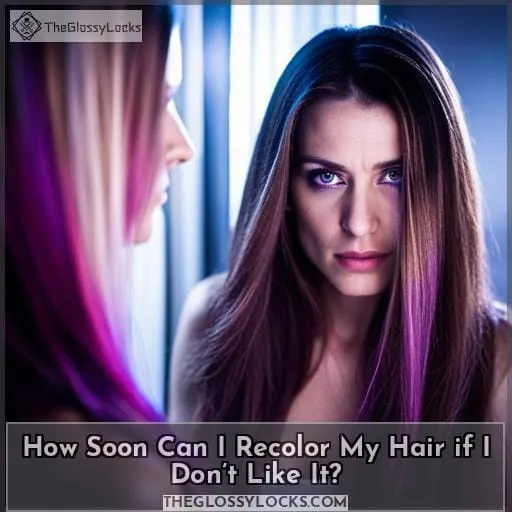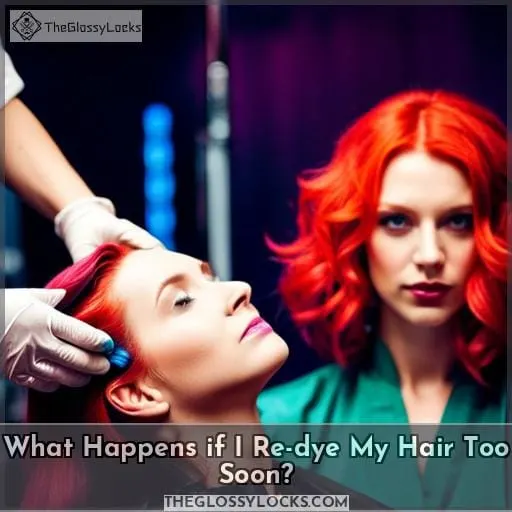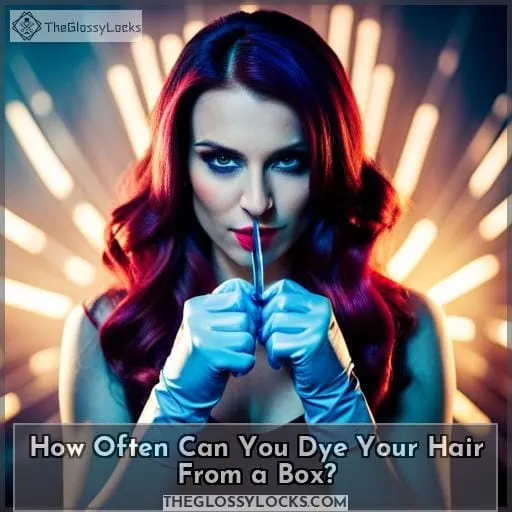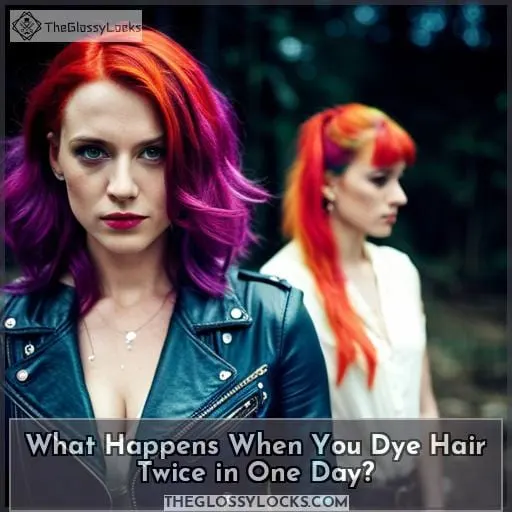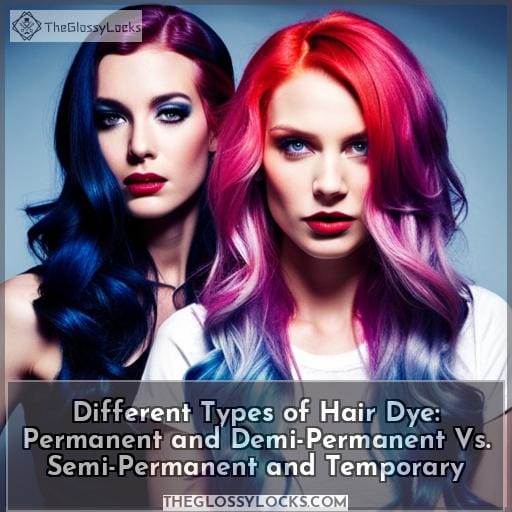This site is supported by our readers. We may earn a commission, at no cost to you, if you purchase through links.
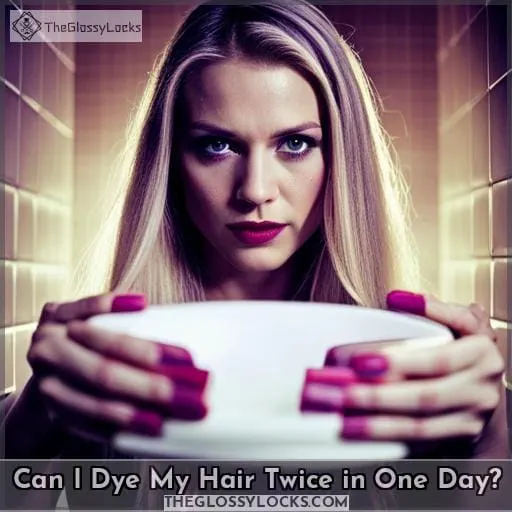
From safety tips for re-dyeing within 24 hours to different types of hair dyes and why waiting is important – we’ve got all the information here! So if you want strong, healthy-looking tresses that are vibrant with color, then read on because having an informed approach towards coloring will help ensure your desired outcome every time.
Table Of Contents
- Key Takeaways
- Can I Dye My Hair Twice in One Day?
- How Soon Can I Recolor My Hair if I Don’t Like It?
- Why Do I Have to Wait to Re-dye My Hair?
- What Happens if I Re-dye My Hair Too Soon?
- How Often Can You Dye Your Hair From a Box?
- What Happens When You Dye Hair Twice in One Day?
- Different Types of Hair Dye: Permanent and Demi-Permanent Vs. Semi-Permanent and Temporary
- The Reason Why You Should Wait Before Re-coloring Your Hair
- Conclusion
Key Takeaways
- Dyeing twice in one day is discouraged due to potential damage.
- Using semi-permanent dyes can cause less cuticle damage.
- Excessive bleaching in one session should be avoided; lighten gradually.
- It is important to deep condition before and after dyeing.
Can I Dye My Hair Twice in One Day?
Are you considering dyeing your hair twice in one day? Doing so can be safe if done following certain precautions. Although there are exceptions, it is generally best to wait at least three days between applications and use purple shampoos for brassiness when lightening hair gradually.
Safety Tips
Take extra precautions with your hair by waiting 3 days up to a week and deep conditioning before reapplying permanent or demi-permanent dye – it’s worth the wait for healthy, beautiful locks!
If you decide to color twice in one day, make sure you’re using semi-permanent dyes as they don’t damage the cuticle.
Be mindful of time limits on boxes and never exceed them.
You should also be aware that bleaching can cause serious damage if done too frequently, so avoid lightening hair in one session.
Hair masks are a great way to protect from fading, while hats and scarves help preserve color when outdoors between touch-ups every 4-6 weeks recommended by professionals for maintenance purposes.
To keep from over-processing, use clarifying shampoos if black dye doesn’t cover well or try natural remedies such as lemon juice instead of harsh chemical strippers, which may yield patchy results best left to experts anyway.
All these safety tips will help prevent extreme dryness, breakage, and other texture issues resulting from frequent coloring without sacrificing style!
Exceptions
Surprise yourself – there are exceptions to dyeing your hair twice in one day! You can follow at-home instructions for re-applying the same color, and salon double processes allow you to keep up with regular maintenance.
Box dyes should be used with caution, though; wait at least two weeks before reapplying permanent or demi dyes. Gradual lightening is best when going blonde, and use purple shampoo if brassiness becomes a problem.
Lastly, color maintenance should occur every four to six weeks, depending on hair type and lifestyle habits. Salon processes should be considered for professional results. Purple shampoo can help combat brassiness in blonde hair.
It is important to exercise caution when using box dyes and wait for a sufficient amount of time before reapplying. Gradual lightening is recommended for achieving blonde hair. If you find yourself in an emergency situation requiring quick results, be mindful of the duration of product application to avoid dryness or breakage.
While waiting between applications may not always be feasible, there are valid exceptions for safely coloring again within 24 hours of the first application.
How Soon Can I Recolor My Hair if I Don’t Like It?
You’re not alone if you’ve ended up with a brassy color after dyeing your hair, botched the box dye job, dyed it black, or want to strip away the existing color. From deep conditioning and using purple shampoo to prevent brassiness when lightening hair, taking caution with products used in between dyes, and leaving stripping treatments to professionals – there are steps you can take for successful recoloring of your hair.
If Your Color Went Brassy
If your hair went brassy after a dye job, try using purple shampoo to counteract the color and keep it looking vibrant. Consider toning with semi-permanent dyes or glazes for added intensity. If you want to DIY, there are many remedies such as beer rinses and baking soda treatments that can help fix brassiness in natural or colored hair.
When coloring at home, make sure to read instructions carefully and not exceed time limits on boxes for maximum safety.
If You Botched Your Box Dye
Be careful when trying to fix an at-home dye job, as too many attempts can become a tangled web of hair damage. Color theory and planning are essential for successful color correction. Research the process first.
Semi-permanent colors provide benefits like moisture without damaging cuticles or lightening natural hair color. Harsh dyes should be avoided due to potential damage from overprocessing. Hair color removers should only be used by professionals.
Brassiness solutions require patience with clarifying shampoo, bleach, purple shampoo, etc.
If You Dyed Your Hair Black
If you dyed your hair black, be cautious about using harsh dyes twice in one day. They can damage the cuticle and cause permanent damage. Consider color removal or correction products if you want to lighten or refresh your color without damaging it further.
If going for a complete change, wait at least two weeks before applying any dye again—longer if possible! Hair care is key during the waiting period; use hats/scarves and deep conditioners to protect from fading and dryness.
Don’t try removing hair color yourself as this could result in patchy results – leave it up to professionals!
If You Want to Strip Your Hair Color
To strip your hair color and start fresh, try a professional-grade color remover or bleach.
- Clarifying shampoo to remove semi-permanent dye.
- A mild bleach for permanent colors.
- Professional interventions like Olaplex and BondPlex treatments.
When correcting unwanted hues, it’s important to consider stripping vs fading, as well as the risks of overprocessing before re-dyeing with semi-, demi-, or permanent hair dyes.
Why Do I Have to Wait to Re-dye My Hair?
It’s important to wait at least 2 weeks before re-dyeing as overprocessing can cause damage. To understand why, it helps to know a bit about color theory and the risks of overprocessing.
Permanent and demi-permanent dyes, as well as harsh bleach, contain chemicals that can damage hair if used too frequently or in excess quantities without proper aftercare. Semi-permanent dyes are conditioner-based, which provide moisture but cannot lighten natural hair color.
They are safe for layering colors in one day without damaging the cuticle layer of your hair strands.
Hair Dye Type: Temporary
Lightening Ability: No
Damage Potential: Low
Hair Dye Type: Semi-Permanent
Lightening Ability: No
Damage Potential: Low – Medium
Demi/Permanent & Bleachable Harsh Dyes (Ammonia) have their own unique properties when dyeing twice on the same day. While they do allow you to change shades more drastically compared with semi/temporary types, this comes with an increased risk of damage due to their chemical composition if not applied correctly by professionals or followed instructions carefully on box dye packaging.
If you’re looking for a dramatic change like going blonde from black, then bleaching should be done gradually instead of all at once within one session. Using purple shampoo between sessions will help reduce brassiness afterwards too! Additionally, professional stylists recommend returning every 4–6 weeks for maintenance, even though waiting periods may vary depending upon the type used.
Usually, longer than two-week intervals are advised prior to attempting another coloring process again yourself at home.
The key takeaway is that most people should avoid double processing back-to-back, especially those inexperienced, since potential consequences could ultimately lead towards dryness, breakage, split ends, and overall loss of suppleness resulting from weakened structure caused by ongoing exposure to extreme heat styling tools, etc.
What Happens if I Re-dye My Hair Too Soon?
Beware of overprocessing your locks; doing so can lead to serious damage and leave you with brittle, dry strands. Redyeing too soon after initial coloring increases the risk of hair breakage due to weakened bonds, split ends due to moisture loss, and color correction issues.
If you want an immediate redo for a new look without risking further damage, it’s best to opt for semi-permanent dyes. These dyes don’t require ammonia or bleach but still provide great coverage on natural coloration alone.
However, if you desire more intense permanent or demi-permanent colors, it’s best to wait 3 days to 1 week before recoloring. This allows enough time for deep conditioning treatments with nourishing ingredients like argan oil or coconut oil to restore much-needed moisture back into the strands.
Otherwise, complications from overprocessing may occur, including texture changes and potential irreversible effects such as thinning out of one’s tresses.
To protect newly colored manes from fading prematurely, use hats or scarves when outdoors. Additionally, use specialized shampoos that help preserve hues longer between salon visits. Ideally, visit the salon every 4-6 weeks, depending on individual needs and lifestyle choices, to maintain beautiful, healthy-looking locks overall.
How Often Can You Dye Your Hair From a Box?
Be mindful when using box dye on your hair – you should wait at least 2 weeks before reapplying permanent or demi-permanent dyes. The amount of time between applications varies depending on the condition and type of color used, but waiting a few days to a week is usually recommended.
For DIY coloring, some experts suggest limiting box dye use to twice per year: once for touchups and again for complete coverage.
For optimum results without damaging your hair, use color-depositing conditioners rather than traditional dyes if possible.
Follow up each application with deep conditioning treatments like masks or leave-in oils to help prevent fading.
Don’t try any dramatic changes too often – stick with smaller adjustments over longer periods so that your scalp has enough time to recover from chemical processing.
If you find yourself wanting drastic change more often than this, consider booking an appointment at a professional salon instead where they have access to higher quality products designed specifically for frequent use without causing excessive damage.
Take care in tracking how much product is being applied during each session as it may cause unexpected reactions if left unchanged too long after initial application due to its interaction within the environment around it, such as temperature and humidity.
Lastly, remember that even though applying box dye may seem easier, there are many risks involved which include potential breakage, split ends, dryness, and other related problems.
What Happens When You Dye Hair Twice in One Day?
Dyeing your hair twice in one day is not something that should be taken lightly. If you’re going to do it, make sure you know exactly what kind of dye and process are being used.
In general, harsh dyes like ammonia-based colors or permanent and demi-permanent dyes can cause minor cuticle damage if they’re applied too often. So, for the sake of avoiding potential hair damage, we strongly recommend against using them more than once a day.
For semi-permanent color though, it’s usually safe to double up since these products don’t typically contain any damaging chemicals.
When attempting same day dyeing with box kits at home, always follow instructions carefully as overprocessing can lead to dryness and breakage from the stress on your locks.
It’s also important to remember that no matter what type of product is used for coloring or layering tones two times within twenty four hours, waiting between applications will help reduce risks associated with overprocessing effects like texture changes or split ends caused by buildup residue left behind when reapplying immediately after another round of treatments has occurred without proper maintenance time given firstly in order for desired results occur successfully instead.
Color theory knowledge may come into play here along with other techniques such as clarifying shampoos, bleach, deep conditioning masks, purple shampoo, etc., which could all prove useful depending on how fastidious you wish to get about fixing a shade result before committing fully again right away through reapplication procedures.
The safest way out, however, would still be leaving this sort of tedious work involving multiple steps towards achieving even hair color coverage throughout strands consistently.
Different Types of Hair Dye: Permanent and Demi-Permanent Vs. Semi-Permanent and Temporary
When it comes to coloring your hair, there are a variety of options, from permanent and demi-permanent dyes to semi-permanent and temporary solutions. Semi-permanent dye offers the benefits of conditioning your hair while adding color without damaging the cuticle or lightening natural color.
Permanent and demi-permanent dyes can cause minor damage to the cuticle if used too frequently, so precautions need to be taken when using these coloring techniques. Knowing basic Color Theory is also important for achieving desired shades when layering colors in one day.
Hair colored with semi-permanent dye tends not to have as long staying power as its counterparts. However, if you take proper care by using masks between applications, avoiding frequent heat tools on dyed locks, and protecting them with hats/scarves during outdoor activities, you can extend longevity significantly.
On the other hand, permanent and demi-permanent color will last much longer, up to 6 weeks, depending on how often you shampoo your tresses. But this doesn’t mean that they don’t require a special aftercare routine. Use clarifying shampoo once every two weeks for best results, fix unwanted shades by waiting 2 weeks before reapplying, and cover stubborn grays more effectively.
Always keep an eye out for signs of overprocessing, such as texture changes and breakage.
The Reason Why You Should Wait Before Re-coloring Your Hair
To keep your locks luscious, it’s best to wait a bit before re-coloring – trust us, you don’t want the devastating effects of overprocessing! Whether using permanent or semi-permanent dyes on natural hair or bleaching for new color trends, there are several reasons why you should wait prior to recoloring.
Reasons To Wait:
- Fixing Colors: When attempting to fix colors that didn’t turn out as expected and avoid permanent dye twice in one day, minor cuticle damage can occur from frequent use of ammonia-based dyes.
- Color Damage: Overprocessed hair can result from frequent coloring, causing fading and brassiness. Heat styling tools and washing too often contribute to this damage.
- Hair Health: Deep conditioning and moisturizing are necessary to restore the health of overprocessed hair and prevent further damage. Incorporating weekly masks into haircare routines can also help maintain healthy strands after multiple color processes.
It’s important to limit repeating processes like bleaching until enough time has passed since the last application (at least 2 weeks). This not only ensures optimal results but also preserves hair health in the long term, saving money spent at salons trying to repair color issues down the line.
Conclusion
To put it bluntly, dyeing your hair twice in one day should be avoided unless it’s absolutely necessary. Permanent and demi-permanent dyes can cause minor cuticle damage, and ammonia-based dyes can damage hair if used frequently.
Moreover, if you dye your hair too soon, you may cause permanent damage such as dry, frizzy, or rough hair. If you do plan to dye your hair twice in one day, it’s best to use semi-permanent dyes as they don’t damage the cuticle.
Additionally, make sure to follow the instructions on the box and wait at least two weeks before re-dyeing in most cases.
With a little bit of research and patience, you can safely dye your hair without causing irreparable damage.

